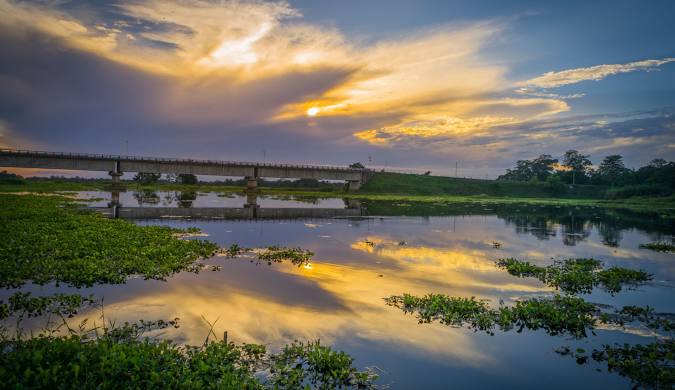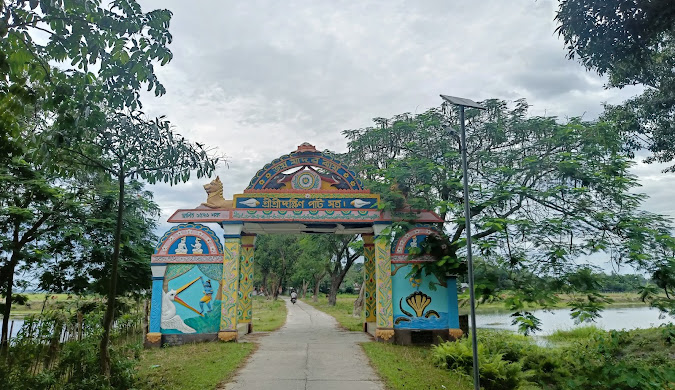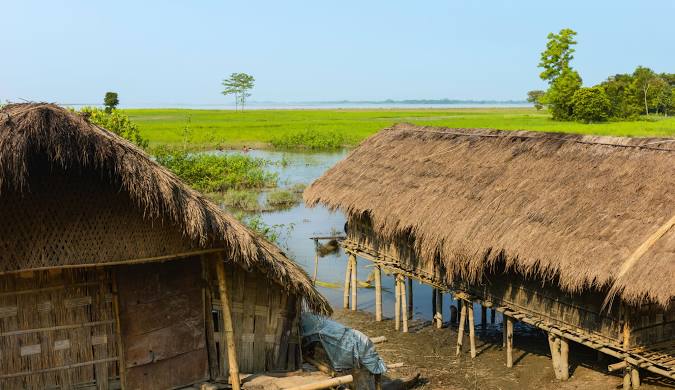Your Journey to India’s Island Treasure Begins
Ever wondered if an entire world can exist on an island in the middle of a river? In Assam, it does. Welcome to Majuli, where time moves differently, and every sunrise brings stories that have been told for centuries.
So, what truly makes Majuli famous? It’s not just its size as the world’s largest river island. It’s a living, breathing cultural treasure, a haven for nature lovers, and a testament to a way of life that exists in harmony with the mighty Brahmaputra. Here, monks still chant ancient prayers while artisans create masks that bring mythology to life. Villages rise on stilts, birds migrate across continents to call this place home, and every meal tells the story of the river’s bounty.
This guide will give you everything you need to plan an unforgettable trip to this remarkable island. From understanding why the Satras matter to finding the perfect homestay, from watching traditional dance performances to cycling through villages that feel untouched by time – we’ve got you covered.

Quick Information at a Glance
| Category | Details |
| Location | Brahmaputra River, Jorhat District, Assam, India |
| Island Size | 880 sq km (world’s largest river island) |
| Best Time to Visit | November to March (winter season) |
| Nearest Airport | Jorhat Airport (JRH) – 45 minutes to ferry |
| Ferry Route | Nimati Ghat to Kamalabari Ghat |
| Ferry Cost | ₹10-15 per person, ₹100 for two-wheelers |
| Ferry Duration | 30-45 minutes depending on boat type |
| Main Attractions | 4 major Satras, Mishing villages, bird watching |
| Accommodation | Homestays (₹800-1500), eco-resorts (₹2000-4000) |
| Local Transport | Scooter rental (₹350-500/day), bicycle (₹100-150/day) |
| Languages Spoken | Assamese, Hindi, Mishing, basic English |
| Currency | Indian Rupee (cash only – limited ATMs) |
| Mobile Network | Patchy coverage, consider digital detox |
| Must-Try Food | Tupula bhat, river fish curry, apong (rice beer) |
| Cultural Highlights | Satriya dance, mask making, traditional weaving |
| Avoid Visiting | July to October (monsoon – ferry disruptions) |
The Living Culture: Why Majuli is the Heartbeat of Assam
The Satras: More Than Just Monasteries
Step into any Satra in Majuli, and you’ll immediately understand why this island is considered the cultural capital of Assam. These aren’t just religious institutions – they’re living museums where neo-Vaishnavite culture thrives in its purest form.
At Kamalabari Satra, the morning begins with the haunting melody of borgeet floating across the courtyard. The monks, called bhakats, move gracefully in their white cotton garments, their prayers creating a rhythm that has remained unchanged for over 500 years. The architecture itself tells a story – notice how the main prayer hall stands on massive wooden pillars, each carved with intricate designs that represent different aspects of Lord Krishna’s life.
But it’s at Dakhinpat Satra where culture truly comes alive. During the Raas Leela festival, which usually falls in November, the entire community gathers to watch performances that transform the courtyard into Vrindavan itself. Young monks become dancers, their faces painted in traditional designs, their movements telling stories of divine love through Satriya dance – one of India’s eight classical dance forms that was born right here in Majuli.
Samaguri Satra offers a different kind of magic. Here, in small workshops that smell of paint and bamboo, master craftsmen create the elaborate masks used in traditional performances. Watch Hem Chandra Goswami work on a demon mask – each stroke of his brush adds character to what will become Ravana or Mahishasur on stage. These aren’t souvenirs; they’re sacred art pieces that take weeks to complete.

Meet the People: The Mishing Tribe and Local Artisans
The real soul of Majuli lies in its people, particularly the Mishing community who have called this island home for generations. Their traditional homes, called chang ghars, rise on bamboo stilts like wooden ships floating above the ground. This isn’t just architectural charm – it’s survival wisdom passed down through centuries of living with the Brahmaputra’s unpredictable floods.
Bolin Pegu, a Mishing weaver from Jengraimukh village, invited me into her home where three generations of women work on a single handloom. The silk thread catches the afternoon light as her daughter creates a mekhela chador in deep red and gold – colors that represent prosperity and joy in Assamese culture. What makes Mishing textiles special isn’t just their beauty; it’s the stories woven into each pattern. The wave design represents the Brahmaputra, while the flower motifs symbolize the island’s fertility.
The pottery village of Salmora showcases another side of Majuli’s artisan culture. Here, entire families work together creating everything from traditional gamochas (hand towels) to decorative items. The clay comes from the riverbank, shaped by hands that learned the craft from their grandparents, then fired in kilns that have been in the same spot for decades.
The Wild Side: Majuli’s Natural Wonders
A Birder’s Paradise
Majuli transforms into a birdwatcher’s paradise between November and March when thousands of migratory birds arrive from as far as Siberia and Central Asia. The island’s numerous beels (wetlands) become temporary homes for species you won’t easily spot elsewhere in India.
Early morning at Molai Beel offers the best birding experience. As mist rises from the water, you’ll spot the majestic Greater Adjutant Stork – locally called hargila – wading through shallow waters. These prehistoric-looking birds, standing nearly five feet tall, are endangered globally, but Majuli provides them crucial breeding grounds. Pelicans arrive in large flocks, their synchronized fishing creating ripples across the calm water.
But it’s the smaller birds that create the real spectacle. Various species of egrets, herons, and kingfishers create a symphony of colors against the backdrop of water hyacinth and lotus blooms. The Northern Pintail ducks paddle in perfect formations, while cormorants dive and surface with silver fish in their beaks.
The best birding spots are along the southern shore near Tengapania and around the smaller wetlands scattered across the island. Local guides, many of them fishermen who know every bird by its call, can take you to spots where you might glimpse the rare Black-necked Stork or the elegant Sarus Crane.
The Brahmaputra’s Influence
The Brahmaputra isn’t just Majuli’s boundary – it’s the island’s lifeline and its greatest threat. This mighty river deposits fertile silt during floods, making the soil incredibly rich for agriculture. Rice fields stretch endlessly, their green expanse broken only by clusters of bamboo groves and small villages.
Yet the same river that gives life also takes it away. Every year, erosion claims portions of the island. Entire villages have had to relocate, taking their Satras and traditions with them. This constant dance between creation and destruction gives Majuli a poignant beauty – everything here feels both eternal and temporary.
Must-See Places: Your Majuli Checklist
The Four Main Satras
Kamalabari Satra stands as the island’s most important religious center. Founded in 1673, it houses ancient manuscripts, traditional weapons, and jewelry gifted by Ahom kings. Visit during evening prayers to experience the spiritual energy that has made this place sacred for centuries.
Dakhinpat Satra specializes in preserving performing arts. The monks here are master dancers and musicians who perform during major festivals. The Satra’s museum displays centuries-old musical instruments and costumes that showcase the evolution of Assamese performing arts.
Auniati Satra holds the distinction of being the first Satra established on the island in 1653. Its library contains rare manuscripts written on bark and palm leaves, including some of the earliest compositions of Saint Sankardeva, the founder of neo-Vaishnavite culture.
Garmur Satra might be smaller, but it offers the most intimate experience. Here, you can participate in daily activities, learn about traditional farming methods, and understand how Satras function as complete communities with their own schools, workshops, and administrative systems.

Beyond the Satras
Tengapania offers the island’s most photogenic sunset views. This quiet village on the southern tip provides unobstructed views of the Brahmaputra as it curves around the island. Local tea stalls serve excellent milk tea as you watch the sun paint the river golden.
The pottery villages of Salmora showcase traditional craftsmanship that has remained unchanged for generations. Watch entire families work together, from digging clay to firing finished products in makeshift kilns.
Jengraimukh gives you the most authentic village experience. Here, chang ghars line both sides of narrow paths, and every household seems involved in some form of traditional craft – weaving, pottery, or bamboo work.
Unforgettable Experiences: How to Truly Live Majuli
Cycle Through Villages
Renting a bicycle transforms your Majuli experience from sightseeing to living. The island’s flat terrain and village paths make cycling both easy and rewarding. Start early morning when mist still hangs over the rice fields and villagers begin their daily routines.
Stop at random villages – people here are incredibly welcoming. Children might follow you curiously while elders offer directions in a mix of Assamese and broken Hindi. You’ll discover small temples, community fishing ponds, and rice mills that don’t appear in any guidebook but represent the real Majuli.
Attend a Satriya Performance
Nothing prepares you for your first Satriya dance performance. The elaborately costumed dancers move with precision that takes years to master, their expressions telling stories of divine love, heroic battles, and moral victories. The accompanying music, played on traditional instruments like khol and taal, creates an atmosphere that transports you to another era.
Most performances happen during festivals, but many Satras can arrange special shows for visitors with advance notice. The intimate setting – usually in courtyards with audiences sitting on mats – creates a connection between performers and viewers that modern theaters cannot replicate.
Try Local Food
Majuli’s cuisine reflects both its island geography and cultural diversity. Tupula bhat – rice steamed inside banana leaves – retains flavors that regular cooking cannot achieve. The leaf imparts a subtle sweetness while keeping the rice incredibly soft.
Fresh river fish curry, prepared with locally grown vegetables and mild spices, represents comfort food at its finest. The Mishing community’s apong – rice beer fermented in bamboo containers – offers a unique taste experience, though it’s considerably stronger than it appears.
Homestays provide the best food experiences. Families take pride in serving traditional meals prepared with ingredients from their own gardens. Don’t miss pitha – rice cakes stuffed with coconut and jaggery – especially during winter festivals.
Catch a Sunset Over the River
Simple pleasures often create the most lasting memories. Majuli’s western shoreline offers spectacular sunset views over the Brahmaputra. The best spots are near Tengapania village or along the ferry route between Kamalabari and Nimati.
As evening approaches, fishing boats return home, their silhouettes creating perfect compositions against the colorful sky. This daily rhythm – unchanged for generations – reminds you that some experiences need no commentary, only appreciation.
Practical Planning: Your Entire Trip, Sorted
Best Time to Visit
Winter (November to March) provides the absolute best Majuli experience. Cool, pleasant weather makes cycling and walking comfortable while festivals like Raas Leela and Poush Parbon showcase the island’s cultural richness. Migratory birds arrive in large numbers, transforming wetlands into natural aviaries.
Pre-monsoon (April to June) brings increasing heat and humidity. While still manageable, temperatures can reach 35°C, making outdoor activities challenging during midday hours.
Monsoon (July to October) should be avoided entirely. Ferry services become unreliable due to rough waters, flooding affects transportation within the island, and many attractions remain closed. The Brahmaputra turns treacherous, making even short boat rides dangerous.
How to Reach Majuli (Step-by-Step)
By Air: Fly to Jorhat Airport (JRH), which connects to major Indian cities through Guwahati. From the airport, hire a taxi to Nimati Ghat (approximately ₹300-400, 45 minutes).
By Train: The nearest railway station is Jorhat Town, about 20 km from Nimati Ghat. Pre-paid taxis and auto-rickshaws are available (₹250-350).
The Ferry Experience: Nimati Ghat to Kamalabari Ghat ferries run multiple times daily. The larger ferry (₹15 per person, ₹100 for scooters) takes 45 minutes and can carry vehicles. Smaller boats (₹10 per person) complete the journey in 30 minutes but don’t accommodate vehicles. Ferry timings can change due to weather conditions, so it’s always wise to check current schedules through the Assam Tourism website for the latest travel advisories.
Getting Around the Island
Scooter rental (₹350-500 per day) offers maximum freedom and remains the most popular choice among travelers. Most rental shops near the ferry ghat provide basic instruction and local area maps.
Bicycle rental (₹100-150 per day) works perfectly for those preferring slower exploration. The flat terrain makes cycling enjoyable, though distances between major attractions can be considerable.
Auto-rickshaws charge ₹10-15 per kilometer but aren’t always available in remote areas.
Where to Stay
Homestays provide the most authentic experience. Mishing families offer traditional stilt house accommodations (₹800-1500 per night including meals) where you’ll share family meals, learn about local customs, and often participate in daily activities like fishing or weaving.
Eco-resorts like Deki Lodge and Me:Po Okum offer comfortable bamboo cottages (₹2000-4000 per night) with modern amenities while maintaining ecological sensitivity.
Government accommodations at various tourist lodges provide basic but clean facilities (₹500-1000 per night) though advance booking is essential.
Budget travelers can find basic guesthouses near major Satras (₹300-600 per night), though amenities are minimal.
Responsible & Safe Travel
Respect the Culture
Majuli’s cultural heritage deserves your respect and understanding. Dress modestly when visiting Satras – full sleeves and long pants for both men and women. Remove shoes before entering prayer halls and maintain silence during religious ceremonies.
Always seek permission before photographing people, especially monks and tribal community members. Many are happy to pose, but asking shows respect for their privacy and customs.
Be Eco-Friendly
Majuli faces constant environmental challenges from erosion and climate change. Carry a reusable water bottle – most homestays provide filtered water for refilling. Avoid single-use plastics entirely, as waste disposal facilities on the island are limited.
Support local artisans by purchasing directly from workshops rather than middlemen in Jorhat. This ensures fair prices for craftspeople and authentic products for you.
Health & Safety
Cash is King: ATMs on the island are unreliable and often out of service. Carry sufficient cash from Jorhat to cover all expenses including accommodation, meals, transportation, and shopping.
Basic Medical Kit: Pack insect repellent, basic medicines for stomach upset, bandages, and any prescription medications. The island has small clinics, but serious medical emergencies require evacuation to Jorhat.
Monsoon Caution: If you must travel during monsoon months, closely monitor weather conditions and maintain flexible travel plans. River conditions can change rapidly, affecting ferry services.
Frequently Asked Questions (FAQs)
Do I really need to book my stay in advance? Absolutely, especially from October to March when demand peaks. Majuli has limited accommodation options, and the best homestays fill up quickly during festival seasons.
Is there good internet on the island? Internet connectivity is patchy and often unreliable. Consider this an opportunity to disconnect from digital distractions and fully immerse yourself in island life.
Can I visit Majuli as a day trip from Jorhat? While technically possible, day trips don’t do justice to Majuli’s offerings. The island deserves at least two full days to experience its culture, nature, and lifestyle properly.
What about food for vegetarians? Majuli offers excellent vegetarian options. Rice, dal, fresh vegetables, and dairy products form the basis of most meals. Inform your homestay host about dietary preferences when booking.
Are credit cards accepted? No, Majuli operates entirely on cash transactions. Even larger accommodations prefer cash payments.
Conclusion & Final Thoughts
Majuli is famous not just for being the world’s largest river island, but for being a feeling – a journey back in time, a celebration of nature’s resilience, and a lesson in living harmoniously with forces beyond our control. Here, spirituality isn’t confined to temples but flows through daily life like the Brahmaputra itself.
Every sunrise over the river brings new possibilities, every Satra visit deepens your understanding of devotional culture, and every conversation with islanders reveals the strength required to build home on shifting ground. Majuli teaches you that permanence isn’t about solid foundations but about adapting gracefully to change while preserving what truly matters.
Ready to explore the heart of the Brahmaputra? Majuli island Assam is waiting, with its monks and artisans, its birds and bamboo groves, its stories and sunsets. This isn’t just another destination on your travel list – it’s an experience that will change how you understand culture, nature, and the beautiful complexity of human adaptation.
Additional Resources & References
For the most up-to-date travel information and cultural insights about Northeast India, visit:
- Assam Tourism Official Portal – Latest ferry schedules, accommodation options, and travel advisories
- Ministry of Culture – Government of India – Detailed information about Satriya dance and neo-Vaishnavite traditions
- Incredible India – Northeast – Comprehensive travel guides for exploring the Seven Sister States
This guide is regularly updated to ensure accuracy. For the latest information about Majuli Island travel, ferry timings, and cultural events, always cross-reference with official tourism websites.
